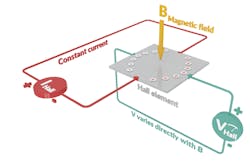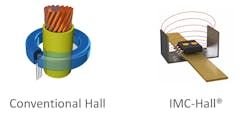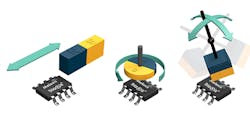What’s the Difference Between Hall-Effect Current Sensing and Position Sensing?
Sensing, in all its forms, is fundamental to so many applications. It invariably involves a material that acts as a transducer, to convert one property to another. In electronics, the sensing element will have physical properties that change as a result of the action of sensing, such as its resistance or reactance allowing the measurement of a change in either current or voltage.
Hall Effect
In 1879, Edwin Hall discovered that when a conductor or semiconductor with current flowing in one direction was introduced perpendicularly to a magnetic field, a voltage could be measured at right angles to the current path. It’s well-established that the Hall-effect results from the interaction of charged particles, like electrons, in response to electric and magnetic fields.
The Hall effect, as applied to sensors, manifests either as a measurable voltage difference across a conductor through which a constant current must be present, or as a measurable current difference across a conductor through which a constant voltage must be flowing (Fig. 1). The voltage difference is proportional to the strength of a magnetic field. This means the Hall effect can be used in two very specific ways, even though the underlying effect is the same in both cases.
1. In terms of sensors, the Hall effect is either a measurable voltage difference across a conductor through which a constant current must be present, or a measurable current difference across a conductor through which a constant voltage must be flowing.
The signal level due to the field variation, relative to background noise, is small (range of µV). Therefore, it requires quite sophisticated signal paths in order to make use of it.
Without wishing to devalue Edwin Hall’s discovery in any way, the effect is really an extension of the use of the Lorentz force, which describes the interplay between electric and magnetic forces on a point charge due to electromagnetic-field variation.
In simple terms, in the case of the Hall effect, the Lorentz force describes the effect a magnetic field has on a charged particle, specifically the direction it will be forced to take as it passes through a conductor exposed to a magnetic field. The physical movement results in more or less charge across the conductor’s surface, which results in the potential difference known as the Hall voltage.
Hall-Effect Current Sensing
The fact that the Hall effect depends on a magnetic field means it can be used as a contactless technology. Thus, it’s non-intrusive, unlike the most common way of current sensing, which consists of using a low-value resistor as a shunt and measuring the voltage drop across it. Using the Hall effect for current measurement is inherently robust in high-power applications, because it doesn’t rely on the ground potential as a reference.
With a conventional Hall-effect current sensor, this means placing the sensor perpendicular to the magnetic field and using a concentrator, normally a ferromagnetic core that’s shaped as either a ring or square, placed around the conductor carrying the current to be measured (Fig. 2). The sensor would typically be held in a small air gap formed between the two ends of the ferromagnetic core.
2. Here’s a comparison of how conventional Hall-effect and Hall-IMC current sensors are positioned.
With an IMC-Hall current sensor, the sensing element is positioned in parallel with the current flow (Fig. 2, again). In this case, no ferromagnetic core is needed; however, a shield might be necessary for crosstalk immunity. This means it can be used to measure the current flowing in a bus bar or PCB track just by positioning the sensor over the bar or track. This type of sensor is enabled by the IMC-Hall technology using the Integrated Magnetic Concentrator (IMC) developed by Melexis (see below).
Fundamentally, it’s the magnetic field generated by the current that’s being detected thanks to the Hall effect, rather than the current itself.
Hall-Effect Position Sensing
The same principle can be used to detect the presence, absence, or proximity of a magnetic field. Effectively, the Hall voltage that results from the movement of a magnet on top of the sensors can be detected, amplified, and processed. This presents an opportunity to use the Hall effect to detect the position or even the orientation of objects with respect to the sensor.
In a simple application this may be relatively coarse, such as when a laptop is open or closed. Or it may be more sophisticated when it’s used to detect linear movement or rotation, such as the variation in position of a movable object (Fig. 3). In this respect, using the Hall effect for position sensing is much more versatile than its use as a current sensor.
3. Using the Hall effect for position sensing is much more versatile than its use as a current sensor.
The Integrated Magnetic Concentrator (IMC)
One of the drawbacks of most Hall-effect sensors, which is related to the way the effect works, is that the Hall plate used to sense the field is limited to only one axis.
To address that drawback, Melexis developed the Integrated Magnetic Concentrator, or IMC, which makes the Hall effect much more flexible. The IMC allows the Hall-effect sensors, while remaining in a plane, to detect magnetic fields from the X, Y and Z axes (Fig. 4). Consequently, the application benefits are multiple, including the flexibility of the sensor’s orientation.
4. The Integrated Magnetic Concentrator allows Hall-effect sensors, while remaining in a plane, to detect magnetic fields from the X, Y and Z axes.
Hall-Effect Sensing in Automotive Applications
With the inclusion of IMC technology, many applications within the automotive industry can employ the Hall effect. By operating in three dimensions, the Hall-effect sensor can be used to detect the position of pedals, the rotation of the steering column and status of the brake lever, and the position of electrically operated seats.
It can also be applied under the hood to monitor moving parts lije pumps and motors, as well as to measure the current drawn by electrified parts of the powertrain, such as the inverter, the battery-monitoring system (BMS), or the on-board charger (OBC).
Conclusion
In basic terms, the Hall-effect phenomenon can be exploited in a number of useful ways, including current sensing and position sensing. Despite great challenges, such as the low signal-to-noise ratio or the impact of stray field, the electronics industry has been successful in developing robust and accurate sensing solutions based on the Hall effect.
In particular, the addition of a strong analog front end and digital signal path, along with proprietary technologies such as Melexis’ IMC-Hall, means the Hall effect can be applied to current measurement and position sensing—even in harsh environments such as the automotive industry.
Nick Czarnecki is the Marketing Manager for Magnetic Sensors at Melexis.
About the Author
Nick Czarnecki
Product Marketing Manager, Magnetic Sensors
Nick Czarnecki joined Melexis in 2011 as a Field Applications Engineer and transitioned to the Marketing Manager role in 2015. His responsibilities include the definition and promotion of Melexis magnetic sensors, including the Triaxis angular sensors.





